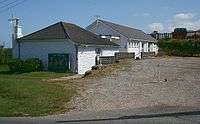Porthtowan
Porthtowan (Cornish: Porth Tewyn, meaning cove of sand dunes) is a small village in Cornwall, England which is a popular summer tourist destination. Porthtowan is on Cornwall's north Atlantic coast about 2 km (1.2 mi) west of St Agnes, 4 km (2.5 mi) north of Redruth, 10 km (6.2 mi) west of Truro and 15 km (9.3 mi) southwest of Newquay in the Cornwall and West Devon Mining Landscape, a World Heritage Site.
| Porthtowan | |
|---|---|
Porthtowan Cliffs seen from West Cliff by R. Spence | |
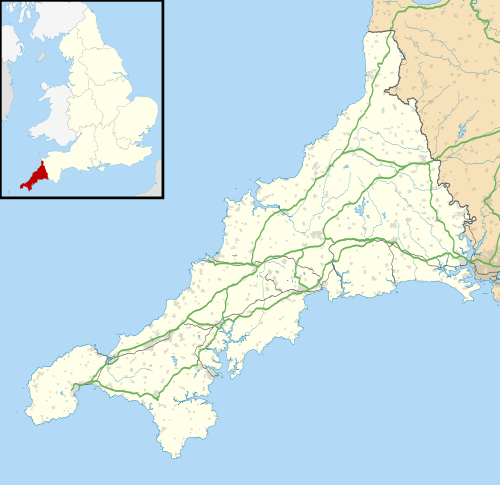 Porthtowan Location within Cornwall | |
| OS grid reference | SW695475 |
| Unitary authority | |
| Ceremonial county | |
| Region | |
| Country | England |
| Sovereign state | United Kingdom |
| Post town | St Agnes |
| Postcode district | TR4 |
| Police | Devon and Cornwall |
| Fire | Cornwall |
| Ambulance | South Western |
Porthtowan is popular with surfers and industrial archaeologists; former mine stacks and engine houses dot the landscape.[1]
Geography
Porthtowan lies along the 627-hectare (1,550-acre) Godrevy Head to St Agnes heritage coast,[2] which is located on the north Cornwall coast of the Celtic Sea in the Atlantic Ocean. It lies between Godrevy Head (with the Godrevy Towans) and St Agnes Head, north of the village of St Agnes.[3][4][5] The Godrevy to St Agnes Heritage Coast has been a nationally designated protected area since 1986. The marine site protects 40 species of mammals and amphibians.[6][7]
Porthtowan is within walking distance of National Trust coastal and cliff-side walks. Between Porthtowan and Agnes Head is one of Cornwall's "largest remaining heathland[s]." Ironically, the heath survived – and was not turned into arable land – because of the soil contamination of previous mining activities. Few plants or species other than heathers and spiders can thrive in the area's environmental condition.[8][nb 1]
Toponymy
Its name comes from the Cornish words "porth" and "tewynn" to mean landing place at the sand dunes.[1]
History
Porthtowan's history is associated with mining and one of its most prominent buildings is a former engine house converted for residential use. Allen's Corn Mill operated at Porthtowan between 1752 and 1816.[10]
Porthtowan owes much of its present-day character to its popularity as a local seaside resort in Victorian and Edwardian times when the local populace from Redruth and the surrounding areas went there, particularly on Bank Holidays.
Mining
Coastal settlements in Cornwall between Perranporth and Porthtowan had copper, lead, iron, tin and zinc mines. Porthtowan mines mainly produced copper.[11]
South Wheal Towan
The South Wheal Towan copper mine also operated in the area. Still visible is its Echo Corner mine stack.[1] The mine had a slide lode that intersected with the main lode, Hamptons and Downright lode. In addition to copper pyrites, brown iron ore was also found in the mine.[12]
Tywarnhayle Mine
The Tywarnhayle mine was opened in 1826 as United Hills Mine but the name was changed in 1848 to Tywarnhayle Mine. It was an important source of copper ore until about 1860.[13] Its engine house, Taylors Shaft, is visible in the hills surrounding the coastal village.[1]
The mine was located about 1 kilometre southeast of Porthtowan. It was the United Hills Mine on 3 February 1830 when an engine boiler exploded and killed nine people. In 1906 money was invested to drain and work the Tywarnhayle mine. Water was piped out by Cornwall's first electrical centrifugal pumps, made by Worthington Simpson, at the rate of 1,000 gallons per minute.[1] The amount of copper ore mined between 1826 and 1906 was 86,800 tons.[14]
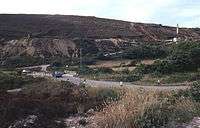 Tywarnhayle mine. This disused mine and its extensive spoil tip is on the north valley side, about 1 km south east of Porthtowan.
Tywarnhayle mine. This disused mine and its extensive spoil tip is on the north valley side, about 1 km south east of Porthtowan. Footpath leading to Mount Hawke from Tywarnhayle Mine
Footpath leading to Mount Hawke from Tywarnhayle Mine
Tywarnhayle Stannary
In Cornwall the mining industry had its own judicial system. Tywarnhayle was one of the four stannaries. There were three others: Blackmore, Foweymore and, lastly, Kerrier and Penwith. The Stannaries managed mining law, taxation, court proceedings and jails.
Wheal Coates
The mine is renowned for its pseudomorphs, in this case tin oxide, or cassiterite, that takes on the shape of the feldspar crystals that it replaces within granite.[11]
- Wheal Coates
- Wheal Coates
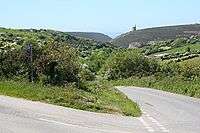 Road Junction. One road leads down into the steep valley which reaches the sea at Porthtowan. On the hillside in the distance is a lone engine house from an old mine.
Road Junction. One road leads down into the steep valley which reaches the sea at Porthtowan. On the hillside in the distance is a lone engine house from an old mine.
Wheal Ellen
Wheal Ellen was a 19th-century copper mine. Remains of the mine are visible. It operated primarily from 1826 to 1862.[1]
Wheal Lushington
Wheal Lushington, also known as the New Wheal Towan, was a copper mine located on a hill overlooking the beach. The engine house that was built in 1872 was never used as an engine house and has since been converted for other uses.[15]
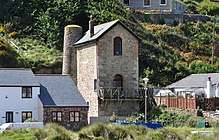 The former Wheal Lushington engine house which has been converted into a café
The former Wheal Lushington engine house which has been converted into a café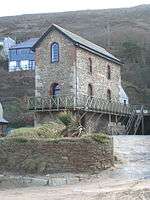 Engine house behind Porthtowan beach now converted into a dwelling house
Engine house behind Porthtowan beach now converted into a dwelling house
Wheal Towan
Wheal Towan was one of Cornwall's most prolific 18th century copper mines.[16][17] In 1772, women and girls worked at the mines, earning 4 to 6 d per day.[18] In 1809 Wheal Towan had a cobbing shed which was a building used to break the ore up with a pointed hammer weighing up to 4 pounds. Teenage girls (bal maidens) sat on low benches and broke the ore to remove the rock and break the ore into small pieces. It was a loud and difficult task, but not as difficult as bucking which came next; this required the ore to be broken down into a powder or granules with a flat-ended cast iron hammer.[19] Some time before 1826 the mine resulted in £130,000 profit, having been mined to a depth of 150 fathoms. It was then closed until 1826. Two 80-inch cylinder steam engines called Wilson's engine from the engineer Samuel Grose (1791–1866) were used in 1826 to drain the mine. The monthly output between January 1827 and March 1828 from the engine ranged from 48.9 to 84.2 million 94 pound bushels.[16][17]
It was also known as West Wheal Towan (1850–1867), Lelant Wheal Towan and West Wheal Lucy (1872). During the period he owned it, the mine provided Ralph Allen Daniell of Trelissick with a fortune estimated at the time as a "guinea a minute". The first underground steam engine was built in Wheal Towan in 1785. It was reopened in 1872 as West Wheal Lucy and abandoned soon after.
The only remains on the surface are burrows created from the mine's operations. The burrows head in the direction of Towan Cross.[20]
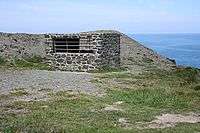 Kites Shaft mineshaft cover, West Wheal Towan mine
Kites Shaft mineshaft cover, West Wheal Towan mine_-_geograph.org.uk_-_23513.jpg) Kites Shaft (disused), a typical old Cornish mine shaft; it has been boxed and had new fittings round the top for public safety
Kites Shaft (disused), a typical old Cornish mine shaft; it has been boxed and had new fittings round the top for public safety
Culture and activities
Beaches
Porthtowan beach is a family and surfing Blue Flag beach. Designated Area of Outstanding Natural Beauty (AONB), along the coast are Gullyn Rock, Diamond Rock and sandstone and slate cliffs.[22][23] It has more recently become well known as a surf resort and the surf club building. This is where the judges can be found for the annual SAS Rip Curl Cornish and Open Longboard Championship. The beach is kept under the constant scrutiny of the St Agnes based charity Surfers Against Sewage,[24] which was founded in 1990 to improve water quality in Chapel Porth, Porthtowan, and Trevaunance beaches.[25]
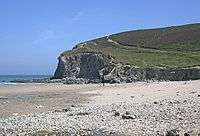 Porthtowan Beach
Porthtowan Beach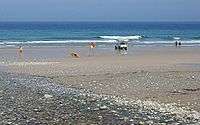 Porthtowan Beach
Porthtowan Beach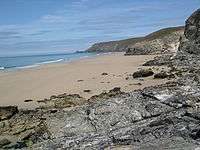 Northern part of Porthtowan Beach
Northern part of Porthtowan Beach- Porthtowan beach
Restaurants and pubs
The Unicorn pub is a beachside bar, eaterie, hotel and hostel, which offers live music, dj's and panoramic sunset views.
Overlooking the Porthtowan Beach is the Blue Bar, which has live music or disc jockeys on the weekend.[26]
Amateur dramatics
An amateur theatre group, Porthtowan Players, formed in 1968,[27] operates from a permanent stage facility within Porthtowan Village Hall. The group puts on a pantomime, musical theatre show, short plays and a youth production each year.
Transport
There is a bus service within Cornwall by a number of operators. The major operators in the Cornwall area are First South West and Hopleys Coaches.[28][29] Service runs through the village of St Agnes and other towns.[30][31] Rail service is offered out of Newquay railway station, Redruth railway station, Truro railway station and other western Cornwall municipalities, which is connected with bus service through the Ride Cornwall and Plusbus programs.[32]
Ferry service is available to the Isles of Scilly from Penzance; Padstow to Rock; and other locations.[33] Air travel is available through Newquay Cornwall Airport[34] and private jets, charters and helicopters are served by Perranporth Airfield.[35]
In culture
- Porthtowan was the inspiration for several paintings by G.E. Treweek entitled: A Glimpse of the Sea, Porthtowan; A Sketch of Porthtowan; and Looking up the Valley, Porthtowan.[36]
Notes
- The land, now owned by the National Trust, between St Agnes and Porthtowan was obtained in 1957 from Viscount Falmouth and others. It is 81.04 hectares (200.25 acres).[9]
References
- Porthtowan, Banns Vale, Mount Hawke and Chapel Porth. St Agnes Forum. Retrieved 28 September 2012.
- "Godrevy Head to St Agnes" (PDF). Natural England. 1989. Retrieved 6 December 2011.
- "Godrevy Head to St Agnes map". Natural England. Archived from the original on 13 October 2012. Retrieved 6 December 2011.
- Ordnance Survey: Landranger map sheet 203 Land's End ISBN 978-0-319-23148-7
- St Agnes Heritage Coast. British Express. Retrieved 18 September 2012.
- St Agnes Heritage Coast. Protected Planet. Retrieved 18 September 2012.
- Species Protected Planet: St Agnes Heritage Coast. Retrieved 18 September 2012.
- Look out St Agnes to Carn Gowla Walk. Archived 23 October 2012 at the Wayback Machine National Trust. Retrieved 28 September 2012.
- National Trust Acquisitions December 2011-2. Archived 3 June 2012 at the Wayback Machine National Trust. p. 29. Retrieved 28 September 2012.
- Allen's Mill. English Heritage National Monuments. Retrieved 21 September 2012.
- Simon Camm. Cornish Rocks and Minerals. Alison Hodge Publishers; March 2010 [cited 29 September 2012]. ISBN 978-0-906720-71-4. p. 50.
- James Bastian Hill; Donald Alexander MacAlister; Sir John Smith Flett. The geology of Falmouth and Truro and of the mining district of Camborne and Redruth. Printed for H. M. Stationery Off., by Wyman & Sons; 1908 [cited 29 September 2012]. p. 241.
- Barton, D. Bradford (1965) A Guide to the Mines of West Cornwall; 2nd ed. Truro: D. Bradford Barton; p. 43
- Barton, D. Bradford (1965) A Guide to the Mines of West Cornwall; 2nd ed. Truro: D. Bradford Barton; p. 47
- Barry Gamble. Cornish Mines: Gwennap to the Tamar. Alison Hodge Publishers; April 2011 [cited 29 September 2012]. ISBN 978-0-906720-82-0. p. 47.
- Samuel Lewis. A Topographical Dictionary of England: With Historical and Statistical Descriptions. Lewis; 1833. p. PT 68.
- William Jory Henwood. Address Delivered at the Spring Meeting of the Royal Institution of Cornwall, on the 23rd of May 1871. 1871 [cited 29 September 2012]. pp. 51–52.
- Lynne Mayers. Balmaidens. Hypatia Publications; 1 June 2004 [cited 29 September 2012]. ISBN 978-1-872229-48-5. p. 27.
- Lynne Mayers. Balmaidens. Hypatia Publications; 1 June 2004 [cited 29 September 2012]. ISBN 978-1-872229-48-5. pp. 64, 63–65.
- D. B. Barton. A Guide to the Mines of West Cornwall; 2nd ed. Truro: D. Bradford Barton, 1965. p. 42.
- Church History. Mount Hawke. GENUKI. Retrieved 28 September 2012. Also see:Mount Hawke Parish Church Archived 10 February 2012 at the Wayback Machine.
- Porthtowan. Beaches in Cornwall. 28 September 2012.
- Mark Rainsley. South West Sea Kayaking. Pesda Press; 15 April 2008 [cited 29 September 2012]. ISBN 978-1-906095-05-5. p. 190.
- SAS / Rip Curl Cornish Open set for next weekend. Porthowan Beach, Cornwall, UK 9–11 August 2002. Surfers Village. Retrieved 28 September 2012.
- Mark Rainsley. South West Sea Kayaking. Pesda Press; 15 April 2008 [cited 29 September 2012]. ISBN 978-1-906095-05-5. p. 35.
- David Else; Fionn Davenport. Great Britain. Lonely Planet; 1 May 2009 [cited 29 September 2012]. ISBN 978-1-74104-491-1. p. 379.
- "Porthtowan Players history". Retrieved 7 December 2012.
- Bus Operators. Archived 18 October 2012 at the Wayback Machine Cornwall Public Transport. Retrieved 22 September 2012.
- Bus tickets. Archived 24 June 2012 at the Wayback Machine Cornwall Public Transport. Retrieved 22 September 2012.
- Porthtowan to Truro Schedule. Archived 30 December 2014 at the Wayback Machine Cornwall Public Transport. Retrieved 22 September 2012.
- Bus maps. Archived 26 June 2012 at the Wayback Machine Cornwall Public Transport. Retrieved 22 September 2012.
- West Cornwall Guide. Archived 24 May 2012 at the Wayback Machine Cornwall Public Transport. Retrieved 22 September 2012.
- Ferries. Archived 8 June 2015 at the Wayback Machine Cornwall Public Transport. Retrieved 22 September 2012.
- Main Page / Travel. Newquay Cornwall Airport. Retrieved 22 September 2012.
- Helicopter Flights Perranporth Airfield. Archived 21 February 2013 at Archive.today Private Jets Charter. Retrieved 28 September 2012.
- Royal Cornwall Polytechnic Society. Annual report. 1892 [cited 29 September 2012]. p. 167.
Further reading
- Bob Acton. Around St. Agnes and Perranporth: Round Walks from Holywell to Porthtowan. Landfall Publications; 1 April 1994. ISBN 978-1-873443-16-3.
- Thomas Shaw. Foolish Dick and His Chapel: The Story of Porthtowan Methodism, 1796–1967. T. Shaw; 1967*.
| Wikimedia Commons has media related to Porthtowan. |
